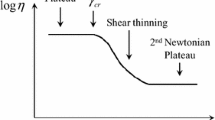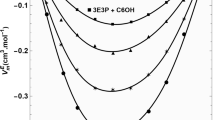Abstract
Context
Viscosity and viscosity index are the crucial properties of lubricant base stocks. Molecular dynamics simulation and quantum calculation were used to simulate the five isomers of C26H54 to study the intrinsic relationship between viscosity, viscosity index, and the molecular structure of isoalkanes. The results showed that the intermolecular interaction energy and the volume of rigid-like groups were the intrinsic factors that affected the viscosity and which could describe the viscosity quantitatively. The molecule conformation was studied by calculating the rotational energy barrier of the dihedral angle in the isoalkane molecule, and combined with molecular dynamics, the effect of temperature on the molecular conformation at 313 K and 373 K was further investigated. The α, β, and γ carbon atoms adjacent to the tertiary carbon in the isoalkane molecule were difficult to rotate due to steric hindrance and could be regarded as rigid-like groups at 313 K. The tertiary carbon and the three adjacent carbon atoms formed a regular tetrahedral rigid-like group at 373 K. The changes in the intermolecular interaction energy and the volume of the rigid-like group with temperatures could better describe the viscosity index and reveal the fundamental reasons that affect the viscosity and the viscosity index. The molecular-level understanding of the relationship between the molecular structure and properties of isoalkanes provided theoretical support and scientific guidance for designing isoalkane molecules with specific properties.
Methods
Molecular dynamics simulation and quantum calculation were performed using Material Studio 8.0 software. The Amorphous Cell module was used to create an amorphous cell. The Foricite module was used for molecular dynamics simulation; the forcefield was assigned as COMPASS II. Nose–Hoover thermostat and Berendsen barostat were applied to maintain the temperature and pressure, respectively. To describe the non-bond interactions, the Ewald method was applied to calculate the van der Waals and electrostatic interactions. The Conformers module was used to study the conformation and the Dmol3 module was used to calculate the conformational energy with fine quality; the functional of GGA-PW91 and the basis set of DNP were used to calculate the energy.
Graphical Abstract







Similar content being viewed by others
Data Availability
The datasets generated during and/or analyzed during the current study are available from the corresponding author on reasonable request.
References
Cerny J, Pospisil M, Sebor G (2001) Composition and oxidative stability of hydro-cracked base oils and comparison with a PAO. J Synth Lubr 18:199–213. https://doi.org/10.1002/jsl.3000180303
Wu MM, Ho SC, Forbus TR (2006) Synthetic lubricant base stock processes and products. Pract Adv Pet Process 17:553–577. https://doi.org/10.1007/978-0-387-25789-1_17
Mondello M, Grest GS, Garcia AR, Silbernagel BG (1996) Molecular dynamics of linear and branched alkanes: simulations and nuclear magnetic resonance results. J Chem Phys 105:5208–5215. https://doi.org/10.1063/1.472363
Fu W, Bai W, Jiang S, Seymour BT, Zhao B (2018) UCST-type thermoresponsive polymers in synthetic lubricating oil polyalphaolefin (PAO). Macromolecules 51:1674–1680. https://doi.org/10.1021/acs.macromol.7b02755
Rudnick LR (2020) Synthetics, mineral oils, and bio-based lubricants: chemistry and technology. CRC Press, New York
Mortier RM, Orszulik ST, Fox MF (2010) Chemistry and technology of lubricants, 3rd edn. Springer, Dordrecht, Netherlands
Xue JY, Dong SQ, Mi PK (2021) Study of the structure-activity relationship of metallocene-catalysed Poly-α-olefin (mPAO) base oil. Mol Syst Des Eng 6:722–729. https://doi.org/10.1039/D1ME00032B
Jabbarzadeh A, Atkinson JD, Tanner RI (2003) Effect of molecular shape on rheological properties in molecular dynamics simulation of Star, H, Comb, and Linear polymer melts. Macromolecules 36:5020–5031. https://doi.org/10.1021/ma025782q
Kobayashi M, Saitoh M, Ishida K, Yachi H (2005) Viscosity properties and molecular structure of lube base oil prepared from Fischer-Tropsch waxes. J Jpn Petrol Inst 48:365–372. https://doi.org/10.1627/jpi.48.365
Scheuermann SS, Eibl S, Bartl P (2011) Detailed characterisation of isomers present in polyalphaolefin dimer and the effect of isomeric distribution on bulk properties. Lubr Sci 23:221–232. https://doi.org/10.1002/ls.151
Kioupis LI, Maginn EJ (1999) Molecular simulation of poly-α-olefin synthetic lubricants: impact of molecular architecture on performance properties. J Phys Chem B 103:10781–10790. https://doi.org/10.1021/jp992399n
Briant J, Denis J, Pare G (1989) Rheological properties of lubricants. Inst. Franc. du Petrole, Edition Techip, Paris
Sun H (1998) COMPASS: an ab initio force-field optimized for condensed-phase applications overview with details on alkane and benzene compounds. J Phys Chem B 102:7338–7364. https://doi.org/10.1021/jp980939v
Sun H, Jin Z, Yang C, Akkermans RL, Robertson SH, Spenley NA, Miller S, Todd SM (2016) COMPASS II: extended coverage for polymer and drug-like molecule databases. J Mol Model 22:1–10. https://doi.org/10.1007/s00894-016-2909-0
Evans DJ, Holian BL (1985) The Nose-Hoover thermostat. J Chem Phys 83:4069–4074. https://doi.org/10.1063/1.449071
Berendsen HJC, Postma JPM, Van Gunsteren WF, DiNola A, Haak JR (1984) Molecular dynamics with coupling to an external bath. J Chem Phys 81:3684–3690. https://doi.org/10.1063/1.448118
Xu G, Wang H (2016) Study of cohesion and adhesion properties of asphalt concrete with molecular dynamics simulation. Comput Mater Sci 112:161–169. https://doi.org/10.1016/j.commatsci.2015.10.024
Bordat P, Müller-Plathe F (2002) The shear viscosity of molecular fluids: a calculation by reverse nonequilibrium molecular dynamics. J Chem Phys 116:3362–3369. https://doi.org/10.1063/1.1436124
MacConochie IO, Newman WH (1961) The effect of lubricant viscosity on the lubrication of gear teeth. Wear 4:10–21. https://doi.org/10.1016/0043-1648(61)90237-X
Balázs F (1949) Theory of viscosity. Nature 164:191–192. https://doi.org/10.1038/164191a0
Touloukian YS, Saxena SC, Hestermans P (1975) Viscosity. Plenum, New York
Kioupis LI, Maginn EJ (1999) Rheology, dynamics, and structure of hydrocarbon blends: a molecular dynamics study of n-hexane/n-hexadecane mixtures. Chem Eng J 74:129–146. https://doi.org/10.1016/S1385-8947(99)00053-4
Moore JD, Cui ST, Cochran HD, Cummings PT (2000) Rheology of lubricant basestocks: a molecular dynamics study of C30 isomers. J Chem Phys 113:8833–8840. https://doi.org/10.1063/1.1318768
Ensley EK (1994) Thermodynamics of asphalt intermolecular interactions and asphalt-aggregate interactions. In: Chilingarian GV, Yen TF, editor. Asphaltenes and asphalts. 1st ed. Los Angels
McCabe C, Cui S, Cummings PT (2001) Characterizing the viscosity-temperature dependence of lubricants by molecular simulation. Fluid Phase Equilib 183:363–370. https://doi.org/10.1016/S0378-3812(01)00448-4
Funding
This work was supported by China petrochemical corporation project (120055).
Author information
Authors and Affiliations
Contributions
Leilei He: methods, writing, and result analysis. Shuo Su: problem selection, writing, and result analysis. Yi Zhao: data analysis. Jun Long: methods, project management, result analysis, and manuscript editing. Leilei He and Shuo Su contributed equally to this work.
Corresponding author
Ethics declarations
Ethical approval
Not applicable.
Competing interests
The authors declare no competing interests.
Additional information
Publisher's note
Springer Nature remains neutral with regard to jurisdictional claims in published maps and institutional affiliations.
Rights and permissions
Springer Nature or its licensor (e.g. a society or other partner) holds exclusive rights to this article under a publishing agreement with the author(s) or other rightsholder(s); author self-archiving of the accepted manuscript version of this article is solely governed by the terms of such publishing agreement and applicable law.
About this article
Cite this article
He, L., Su, S., Zhao, Y. et al. Intrinsic relationship between viscosity, viscosity index, and molecular structure of isoalkanes. J Mol Model 29, 101 (2023). https://doi.org/10.1007/s00894-023-05494-8
Received:
Accepted:
Published:
DOI: https://doi.org/10.1007/s00894-023-05494-8




